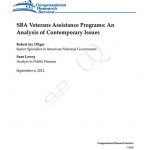 SBA Veterans Assistance Programs: An Analysis of Contemporary Issues
SBA Veterans Assistance Programs: An Analysis of Contemporary Issues
Robert Jay Dilger, Sean Lowry
Congressional Research Service
First published September 2012
Several federal agencies, including the Small Business Administration (SBA), provide training and other assistance to veterans seeking civilian employment. For example, the Department of Labor, in cooperation with the Department of Defense and the Department of Veterans Affairs, operates the Transition Assistance Program (TAP) and the Disabled Transition Assistance Program (DTAP). Both programs provide employment information and training to service members within 180 days of their separation from military service, or retirement, to assist them in transitioning from the military to the civilian labor force.
In recent years, the SBA has focused increased attention on meeting the needs of veteran small business owners and veterans interested in starting a small business, especially veterans who are transitioning from military to civilian life. In FY2011, the SBA provided management and technical assistance services to more than 100,000 veterans through its various management and technical assistance training partners (e.g., Small Business Development Centers, Women Business Centers, Service Corps of Retired Executives (SCORE), and Veteran Business Outreach Centers). The SBA also responded to more than 85,000 veteran inquires through its SBA district offices. In addition, the SBA’s Office of Veterans Business Development administers several programs to assist veteran-owned small businesses.
Congressional interest in the SBA’s veterans assistance programs has increased in recent years primarily due to reports by veterans organizations that veterans were experiencing difficulty accessing the SBA’s programs, especially the SBA’s Patriot Express loan guarantee program. There is also a continuing congressional interest in assisting veterans, especially those returning from overseas in recent years, in their transition from military into civilian life. Although the unemployment rate (as of July 2012) among veterans as a whole (6.9%) was lower than for nonveterans (8.3%), the unemployment rate of veterans who have left the military since September 2001 (8.9%) was higher than the unemployment rate for non-veterans.
The expansion of federal employment training programs targeted at specific populations, such as women and veterans, has also led some Members and organizations to ask if these programs should be consolidated. In their view, eliminating program duplication among federal business assistance programs across federal agencies, and within the SBA, would result in lower costs and improved services. Others argue that keeping these business assistance programs separate enables them to offer services that match the unique needs of various underserved populations, such as veterans. In their view, instead of considering program consolidation as a policy option, the focus should be on improving communication and cooperation among the federal agencies providing assistance to entrepreneurs.
This report opens with an examination of the current economic circumstances of veteran-owned businesses drawn from the Bureau of the Census 2007 Survey of Business Owners, which was administered in 2008 and 2009, and released on the Internet on May 17, 2011. It then provides a brief overview of veteran employment experiences, comparing unemployment and labor force participation rates for veterans, veterans who have left the military since September 2001, and non-veterans. The report then describes the employment assistance programs offered by several federal agencies to assist veterans in their transition from the military to the civilian labor force, and examines, in greater detail, the SBA’s veteran business development programs, the SBA’s Patriot Express loan guarantee program, and veteran contracting programs. The SBA’s Military Reservist Economic Injury Disaster Loan program is also discussed.